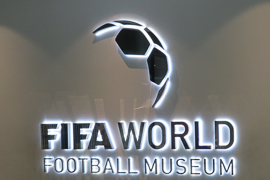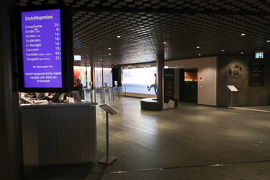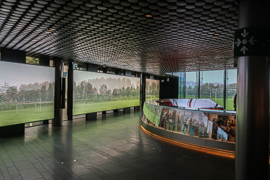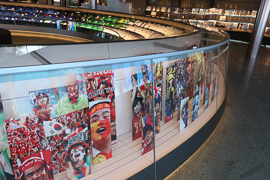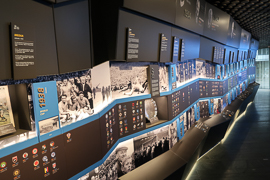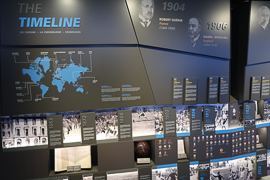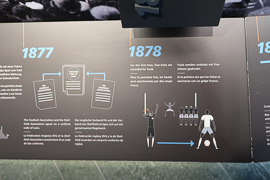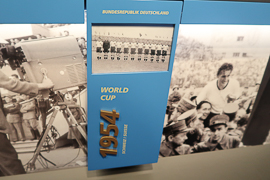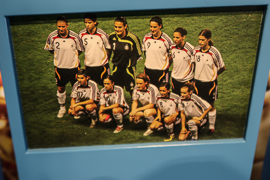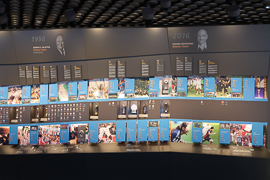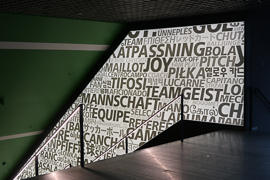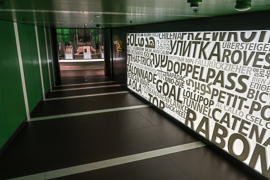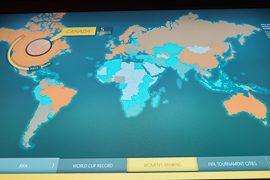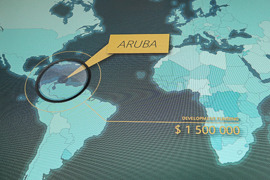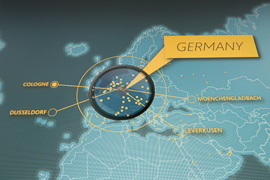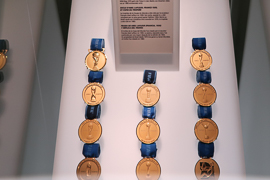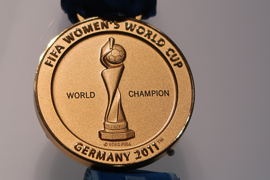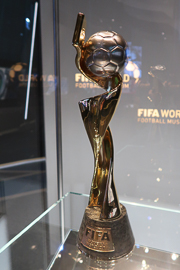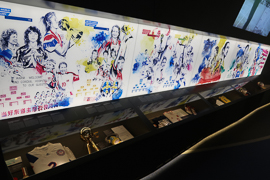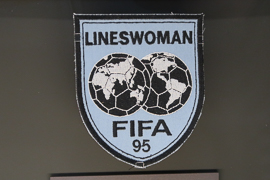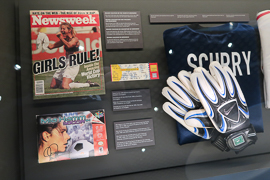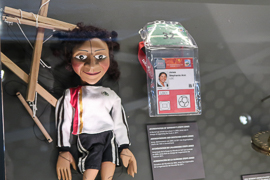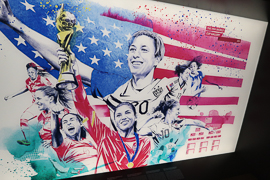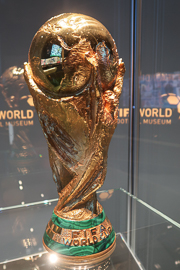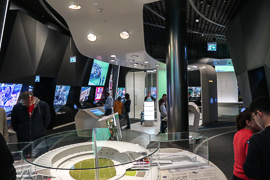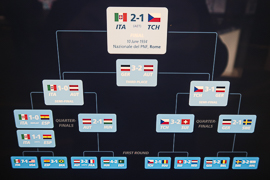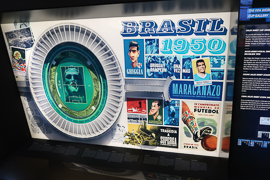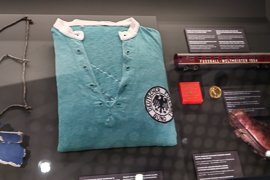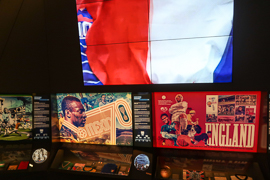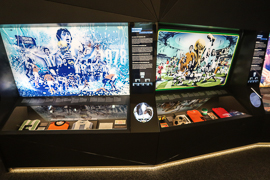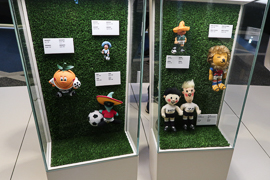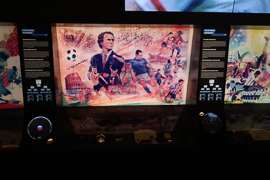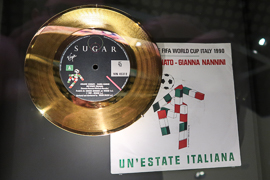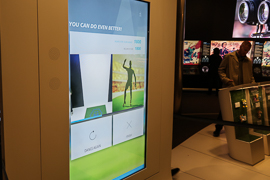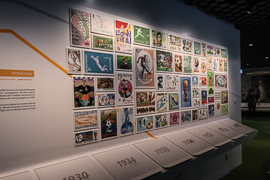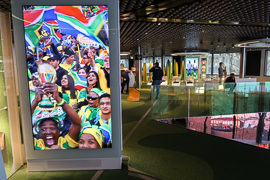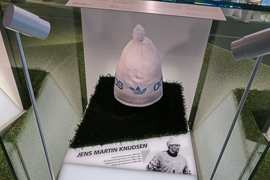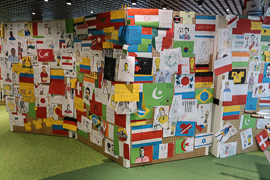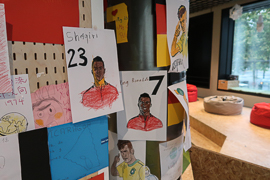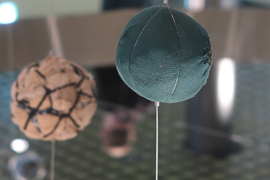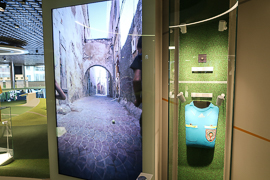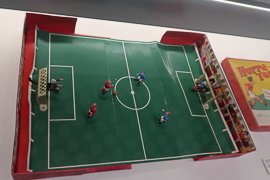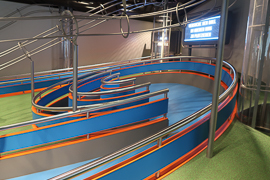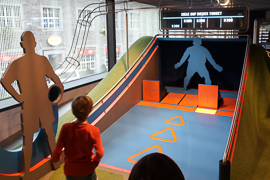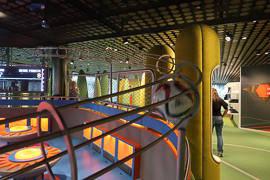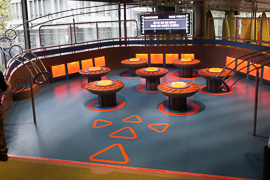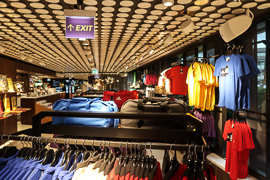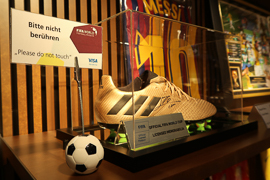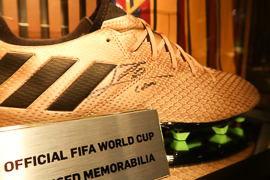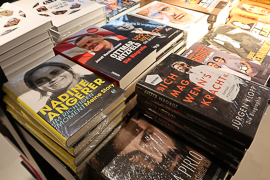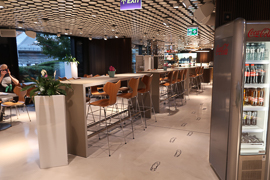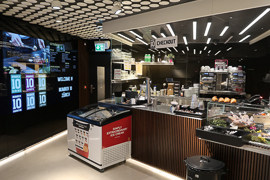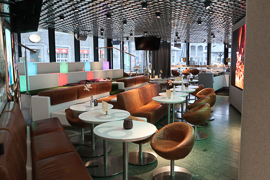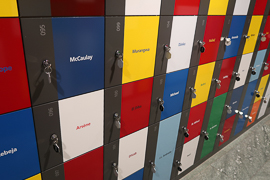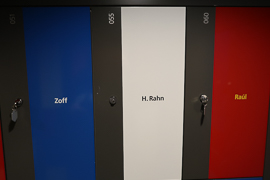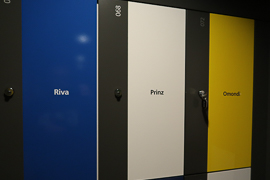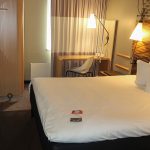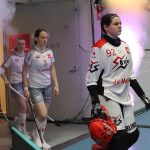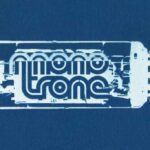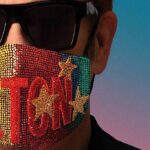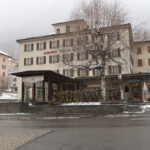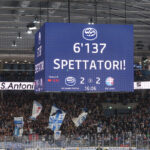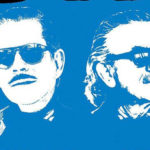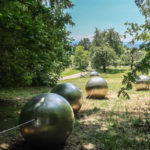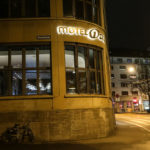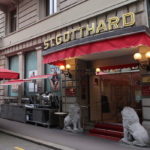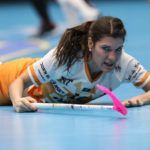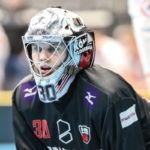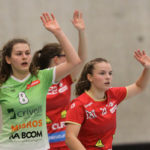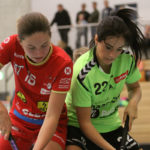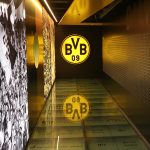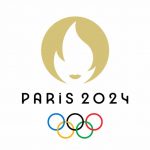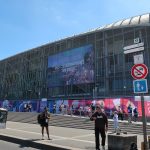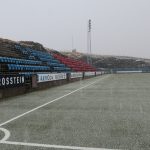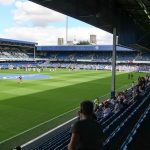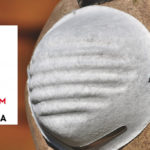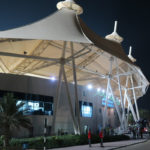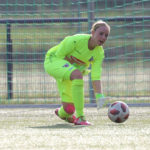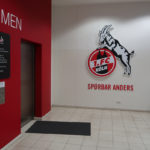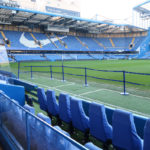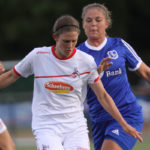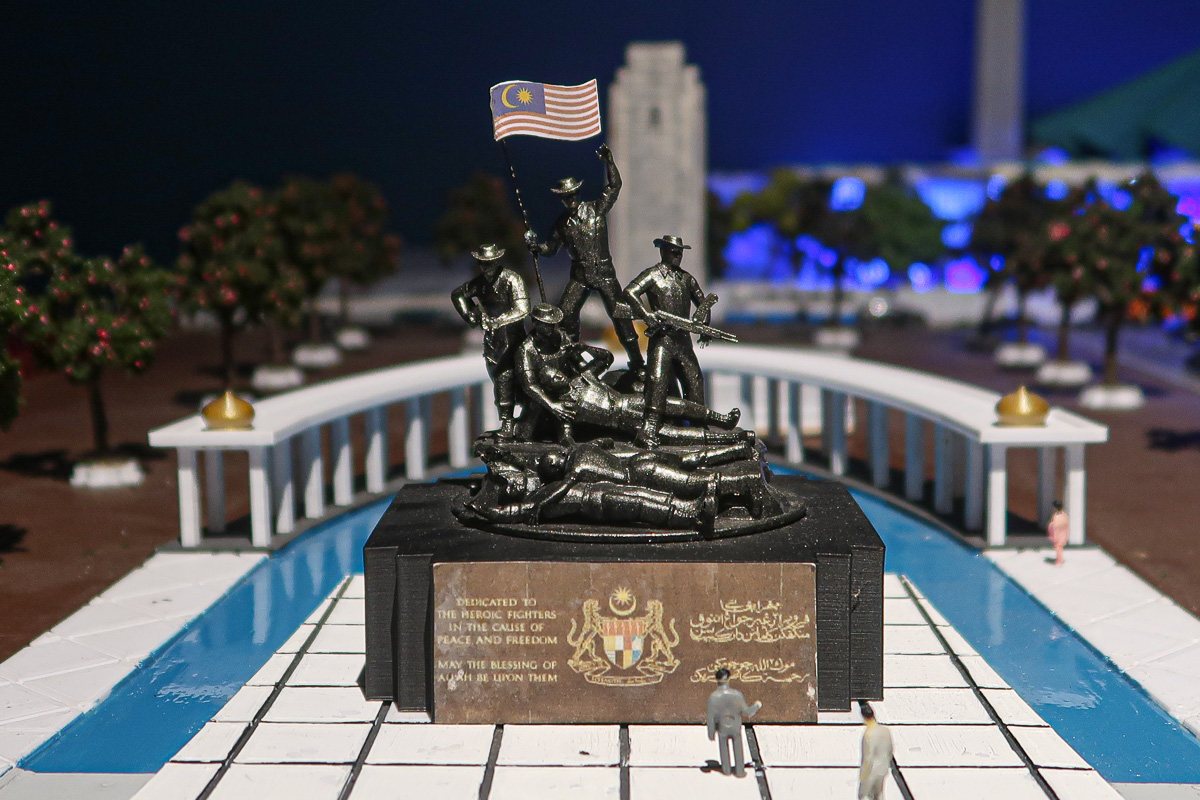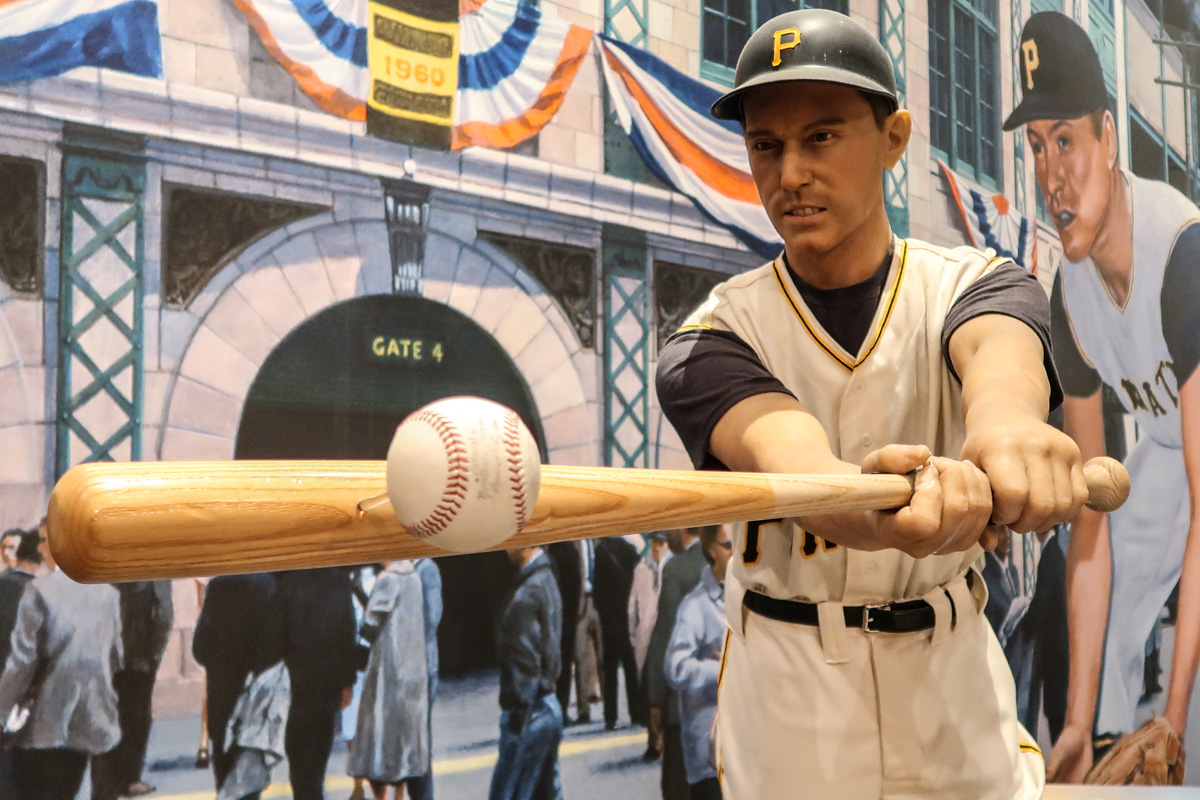The Swiss metropole Zurich is FIFA city. Even if you haven’t ever seen them from inside, the headquarters of the most important individual sports federation in the Zurich hills is majestic and impressive. Thus, it is not that surprising that the FIFA also installed a public temple of soccer in their hometown. Though the FIFA World Football Museum is situated in Zurich, it is regarded to tell you a global story of the sports. I was very interested in how it for example compares to the Hockey Hall of Fame when I visited it in late October 2018. I had high expectations towards the place and was really curious whether it will meet it.
FIFA Museum – Location & Admission
If you leave the S Bahn trains at Zurich-Enge train station, it will definitely be hard to miss the FIFA World Football Museum. It is directly located at the Tessinerplatz in front of Enge, which also offers numerous tram connections. The exact adress is Seestrasse 25. The FIFA Hotel Ascot is across the street. Lake Zurich is just a short walk away.
The museum opens at 10am and closes at 6pm on Fridays and Saturday, 7pm all other days. The museum does not open on Mondays. The adult admission is 24 CHF, which is comparably reasonable for a Swiss museum.



FIFA Museum – The Exhibition
You enter the museum through a comparably tiny entrance. The ground level exhibition is called “Planet Football”. From there, you typically use stairs to go down to Level -2. There is an exhibition about “The Foundations” and “The FIFA World Cup Gallery”, which concludes with a soccer movie. From there you enter Level 1 for “The Fields of Play”. You exit through the shop in 2nd floor, from where you go down back to the entrance area. Regarding the number of altitude meters you walk, this could rather be an Alpine Club Hall of Fame. If you by the way are not too confused already, you might have missed Level -1. There are no exhibits at this level.


Level 0 – Planet Football
Your first steps in the FIFA exhibition are just as you would expect them to be: overwhelming. Planet Football shows the history and geographical spread of the sports (is there any country missing). The core eyecatcher thereby is likely the rainbow-alike presentation of all national team kits of all member associations.









The national team / member association kit exhibition is accompanied by the history of FIFA on one wall. In The Timeline, you find all FIFA presidents, the development of the rules, the development of the member associations as well as important events like World Championships. Overall, this leads to a very promising beginning of the exhibition.







Level -2 – Planet Football
Going down two levels to Planet Football is really impressive as well, with words around the sports shown on one wall. The first part of this level majorly deals with the global importance of soccer. For example, you can see examples of all the different competiions the FIFA is organizing, including less-in-focus ones like Beach Soccer or the Junior World Cups. In this area, there are also interactive screens where you can not only learn about the success of the current member associations and much more. For example, you see, how much funding the local associations receive from FIFA for development (which can be quite much, compared to the country size).










Thereafter, you enter an area which is fully dedicated to the FIFA World Cups. It also holds the original FIFA trophies for men and women. The women exhibition is comparably small, but quite nicely illustrated and selected.









One part of the exhibition about the Men’s World Cup is made up very similarly to the women one. However, there are some very nice additional ideas. You may for example try to identify the World Cup mascots just by touching them or dance original goal scoring dances. I also liked the idea that you can try out different World Cup stadium seats and compare them. This seating section is also the waiting area for the next section, a cinema.
















The cinema section is mandatory, you cannot pass it. You enter the cinema from the rear. After the some ten minute movie, you exit through doors in the screen and take the elevator to Fields of Play. The movie is a potpourri of soccer and World Cup moments and shall “emotionalize” you by that. Honestly, at this point, the exhibition (which really liked so far) started to get worse. I also could not understand why you have to show people like Joseph Blatter. The screen is some 180 degrees, so that it is at least technically quite amazing. The glass elevator to second floor also passes Planet Football again (no way to enter / exit), which is giving quite nice views from another angle.



Level 1 – Fields of Play
It is hard to say what Fields of Play is really about. Maybe, you should translate it to “Global influence of soccer”. It tells stories about how the sports influenced things. On the first picture, for example, you see stamps and letters about FIFA World Cups. There are also social projects and improvements, which are shown on video screens, or a Moroccan girl being a top level referee in the Moroccan (men) league. On the other hand, you also find the beanie of legendary Faroe Island’s goalie Jens Martin Knudsen. One section I especially liked was that you are able to listen to FIFA World Cup songs – not just the official ones, but also some which were very present during the tournament.


















Level 1 – Pinball
Finally, it does not add any education to the museum, but Pinball is definitely enjoyable and fun. First you register with your entrance ticket, which gives you a name of a soccer player. Then, you have five different stations, where you need to do something with a soccer ball. In one section, you do free kicks, in another you dribble etc. With each section, you receive additional balls for the Multiball, which is just like a soccer pinball machine. It gets quite stressful if you made all five extra balls, though. All these sections lead to a total score – of course there is a leaderboard. This part is also very attractive if you travel with children, of course.





FIFA Museum – Services & Events
The most important service in the FIFA World Football Museum is of course the soccer souvenir store you just have to pass through at the end of the visit. There are some quite interesting items like replicas of historic national team dresses. You may just select items of the “big soccer nations” (men soccer, of course!), though. In addition, you may select from a range of soccer books, including few of female athletes. There is even a soccer boot signed by Messi. Unfortunately, no price given.





The museum comes with three refreshment facilities (all outside the ticketed area), a Cafe-bar and a bistro on Level 2 and a Sports Bar close to the entrance with additional doors to street level. I just quickly checked the prices of the bistro, which felt to be quite fine.




At least parts of Level -1 are used for the public of the museum: there is wardrobe and a narrow toilet. The lockers are quite cool, as they are not just numbered, but also named after different soccer stars. Overall, the toilets all over the museum were fine, but not too overwhelming.


FIFA Library
Part of the museum is also a library, which is advertised to have roughly 7,000 items. Unfortunately, the library is having more limited opening hours. This includes that the library is not open on weekends. Thus, I could not visit the place.
FIFA Museum – My View
Before I entered the FIFA World Football Museum, I already knew: either it will be an overwhelming visit – or I will be disappointed. Unfortunately, it is the second one. I just expect the FIFA to deliver an amazing museum. They got all the potential to do so – financially and also the way the sports is organized internationally. The first impression is maybe a bit lousy, but you really get flashed of Planet Football – unfortunately the exhibition just gets the weaker the longer it takes. After being on the very lowest floor, women soccer does not play a role at all. Junior Soccer? In fact not existing. Beach soccer and Futsal? Extremely limited exhibits.
Too politic or too small?
For me, there are two key reasons for this partial failure: first of all, there is too much politics in that sports. You have to deliver certain stories just to make every federation and official happy – and then you miss that space for things which would really be worth to show. This also directs to the second key fact: the museum is nicely located, but the exhibition space is just too small. It starts so good, the first two sections are so good – and then, it just feels something is missing. I would feel an appropriate soccer museums needs at least double or triple the space. So the museum to me is like the walk through it – full of ups and downs, ending with a walk downstairs. Or in soccer words: FIFA played an excellent first half of the match, but then just refused to play on. Bad luck! Regarding soccer museums, I had a much better time at Old Trafford, for example.
More about Switzerland
Here are all other postings related to Switzerland:

While my Song of the Week posts have been rather short the last weeks, this one will be a long one ...

Returning from my Six US States and Nashville trip, having a business event in Munich this weekend and heading to Las Vegas ...

I am just sitting at the American Express Centurion Lounge in Heathrow (LHR), ready to head to the United States ...

I am in Istanbul this weekend and spend some time in Türkiye. A lot of preparation is currently ahead of ...

On 21st May 2025, I headed to another Sound of Nashville show in Cologne. Caylee Hammack closed their short four ...

Rock of Ages in Bremen, ice hockey in Stockholm and maybe (not yet confirmed) a concert in Cologne - I am ...

As I am traveling to Sweden for the national floorball finals this weekend, I had to prepare my album reviews ...

I had a rather mixed week this week - and that's somehow my new Songs of the Week edition is like ...

An intense week lays behind me. I started a new job on Tuesday and I am thus full of new ...

Covering all four matches of the Swiss Floorball Cup Finals in February 2025 required me having two nights in Bern, ...

At the 2025 Country To Country in Berlin, Sid Bader has been one of the very few European acts, who ...

While most of the major music releases take place on Fridays, this one is in fact a Wednesday one. Boyfriend ...

Will Gotthard top the Swiss charts again? Based on an impressing streak by the Swiss hard rockers, this just feels ...

The 2025 Country To Country in Berlin took quite a lot of energy from me. On top of that, there ...

Another Sound of Nashville country concert right before I headed to Pittsburgh: on 25th February 2025, Drake Milligan had a ...

After the men's small field Ligacup final, the ladies had their decider. The match-up of two third teams of each club, Skorpion ...

It was already dark outside when Sporthalle Wankdorf in Bern hosted the last match of the Swiss Cupfinal day. On ...

The ladies again: after the two Ligacup finals have been held, Sporthalle Wankdorf was transformed into the cozy normal field atmosphere, ...

22nd February 2025 featured the Swiss Floorball Cup finals. The morning sessions featured the Ligacup, i.e. the competitions on the small ...

In exactly two weeks, on 6th March 2025, Country To Country (C2C) Berlin is kicking off with the The Bluebird ...

The floorball week in Italy exhausted me more than I expected that. While I hoped to built up a backlog ...

The World Floorball Championship Qualifications are in focus of my coverage this weekend. Nonetheless, I try to provide you with ...

I have to admit that that I was afraid about that moment. Two of my favorite national teams, the Hungarian ...

Apart from my favored Hungarian national team, the Swiss Unihockey delegation competed the World Floorball Championships in Lignano Sabbiadoro. On ...

I am on a trip through several European countries this weekend. Nonetheless, of course, it is time to have a ...

Supporting the Faroe Islands at the EHF Women Handball Euro 2024 in Basel, Switzerland, made me look for a stay ...

I'm in Finland this week, featuring two floorball match. However, the Nordic country is not represented in my Songs of the ...

After I skipped last week's Songs of the Week (and merge the three songs I had for it into this post), ...

My Flyctory.com album review year 2025 starts with deathcore from Switzerland. The band Paleface Swiss releases their third studio album Cursed ...

Even though the bets felt to be more than clear, this match-up felt too tempting. On 3rd December 2024, the ...

Happy Thanksgiving (especially to my North American followers)! While the North American music market is currently rather concentrating on Black ...

Ladies and gentlemen (and all the others of course as well), we got it: here is my first Songs of the ...

The first full week of November definitely kicks off the album season of the year. I have been loaded with ...

Finally, I made it - after featuring so many concerts of different genres, I headed to Essen in the German ...

I had a very tough business trip to Paris this week. Nonetheless, I somehow managed to compile this list of ...

One of the key challenges of visiting the last stage of the German Rock of Ages musical tour 2024 in ...

Damn, I miss the Faroe Islands. I had a lovely weekend there last week. In the meantime, the weather and ...

Dresden is back on the list of major venues for athletics events. On 30th August 2024, the capital of Saxony ...

I still don't really manage creating a proper backlog of already prepared posting. Thus, the last weeks have been very ...

This edition of my Songs of the Week feels like a ballad edition. There are a lot of gentle and emotional song ...

What a week - I returned from my tennis coverage in Newport, now I am at the Olympic Games in ...

For the final 2024 shows of the musical Rock of Ages, I had two different hotels in Zurich. I spent ...

Somehow, I can never now if the upcoming week is a "good one" or "bad one" regarding new releases. While ...

Time to say good-bye. The 8th to 9th June 2024 trip to Zurich featured the last four shows of the ...

This week, I am in Munich, watching a couple of Rock of Ages shows. The week is more busy and demanding ...

The Swiss Floorball Superfinals 2024 in Fribourg gave me a bit of a travel headache. I would have made it ...

In my introductory posting, I already introduced you to the concept of 3x3 Floorball and the first World Floorball Championships ...

After the Place 7 and Place 9 machtes at the beginning of the day, 12th May 2024 in Lahti solely ...

In the world of floorball, running into Sweden is typically the toughest faith you can have. The Swiss Under 19 ...

Despite the World Floorball Championships coverage, I of course want to keep my Songs of the Week updated. Due to the ...

After the Swiss National Team had a rather disappointing last period in their second match against Czechia, it was time ...

Time to get the (potentially) better spot for the semifinals. The second floorball match on the main court of Lahti's ...

Even though the match between Latvia and Switzerland was obviously a match in the top 8 nations section of the ...

Snow in April! After I had some snowfall after the Swiss Floorball Superfinals (my coverage of the women's match / ...

Three and a half hours after the women's final's face-off (and just some 40 minutes after its ceremonies), BCF-Arena in ...

On 20th April 2024, I headed to Switzerland. The Swiss Floorball Superfinals, held in Fribourg for the first time, required ...

If you read the band name Folterkammer, which is German and translates to "Torture Chamber", you rather think that this ...

I love to browse music and run into releases by artists who I did not know before. In line with ...

A lot of traveling is ahead of me. I just returned from a trip to Bochum, watching my first two ...

France, Tunisia, Saudi Arabia and Malaysia - I am just coming back from a massive aviation trip, which is the ...

I struggled a bit compiling the Songs of the Week this time. The partial flight miles for my current trip ...

February 2024 is quite an intense month for me. Even though the trips I have planned and done are comparably ...

On the first weekend of January 2024, I had the opportunity to feature two Swiss floorball matches on the same ...

I am very likely not prolonging my Lufthansa Senator status after it expires in February 2025. Thus, when my wife ...

Carnvial in Cologne - and I am in he United Arab Emirates this weekend. It is rather party season, no ...

Happy New Onbaord-Food Year! At least, there is one flight experience from 2024 in this posting already, a Lufthansa Business ...

The key reason why I traveled to Switzerland on Saturday, 6th January 2024, was the match between UH Lejon Zäzwil ...

There are nowadays not too many opportunities for me any more to see two or more (meaningful) floorball matches on ...

While I still had a rather short list of album releases, there was already quite a lot of stuff for ...

Is it really New Year's Eve already again? The last day of the year? I am posting this one in ...

Unfortunately, I could not complete the Country Christmas Playlist this year due to technical issues. However, since the days become ...

I am a bit of angry as the tool I loved to use to scan for new country releases does ...

I had a quite intensive week, exploring several interesting rail trips as well as being back in Pittsburgh and in ...

I spent almost the entire week at work in Dublin at one of our offices. Quite an intense time, which ...

Unfortunately, I had to kick out quite a lot of songs from my list, which I really liked. They just ...

ibis Styles time in Switzerland: while the previous review of the Accor brand I shared with you has been the ...

There is somehow always some sort of "topic" behind each and every Songs of the Week episode. If I would pick one ...

When Swiss International Air Line recently released the seat map of their new Airbus A350 fleet, a real advantage of ...

While the first match at Mobiliar Arena between Floorball Köniz Bern and Tatran Stresovice was the first leg of the ...

The Songs Of The Week is one of my favorite categories of posts on my blog. Even I don't know how the ...

The Floorball Champions Cup 2024 indeed feels much more like a "real" European Cup competition introducing home and away matches ...

It is just mid-year 2023 and I already start working on my 2024 Rock of Ages International Tour list. I am sure ...

I have quite intense weeks at work, not too many thrills on the Flyctory.com side. The next weeks will have ...

I was a bit confused when I tried to prepare this posting about the Swiss death metal band Uncaved and ...

After some rather intense week of traveling, I feel rather happy to spend the next two weekends in and around ...

Why not doing some jazz-pop in summer? Quite early before the release, I had the opportunity to listen to Sequel by ...

Newcomers and established artists, rock and schlager, party songs and deep messages - I feel that this edition of my ...

The act name Annie Taylor sounds like a solo artist from an English speaking country. However, it is the name ...

The easy, convenient and typically also rather affordable style of an ibis hotel meets some boutique touch. That's about roughly ...

The metal band Green Labyrinth debuted with their 2014 album Shadow of the Past. Since then, it took them almost nine ...

I typically rather focus presenting new and emerging act in my Song of the Week, but this time, the list of ...

I have struggled quite much with health issues this week - which also prevented me to travel to some British Rock ...

After the volume of songs in the last two weeks has been rather thin, this week's Songs of the Week comes with ...

Preparing for the releases as of 31st March 2023, I ran into the album Me Megalomaniac by the band Beyond Frequencies. I ...

Swiss Pat(rick) Burgener is typically rather known for winter sports, for high jumps and speedy rotations. However, since 2018, he ...

After my most recent edition of my Songs of the Week majorly featured German artists and a lot of pop, my song ...

I love gathering songs for Songs of the Week, as the result is so unpredictable, even for me, until short before ...

Damn, it is already four years... And it is more than 2,750 postings since then. On 25th February 2018, I ...

I am kicking off the most stressful part of the year, quite likely. This week, I headed off to Peterborough ...

The ISTAF Indoor in Dusseldorf was truly an sports event I was looking forward to very much. First of all, ...

Oh wow, I really have to limit myself this week. There is so much good music being released this week ...

Welcome to the first Songs of the Week posting in 2023! Despite the music industry is slowly getting back to business, I ...

I guess that the next weeks will be more intense. Depending if you look at the publishing or the cut-off ...

Since I started working with Flyctory.com, I present you a list of my favorite songs at the end of every ...

"Little Christmas" - as there is Thanksgiving in the United States, the volume of new releases is significantly reduced, just ...

I am always glad when I run into genres, which are not that frequently covered on Flyctory.com. Indeed, instrumental music ...

Some thirty years ago, there was Somebody to Dance with Me. The song started in some clubs in Switzerland. In January, ...

It is twelve years ago since Börni released her last album. However, the Swiss artist gained some focus on my ...

I had an amazing week in Cyprus and am just about to prepare for my second trip to the Weird ...

Even though there are quite a bunch of German (language) songs and German artists in the set of new releases ...

Honestly, I had a lot of 1970's and 1980's songs in mind the last days - so exclude me in ...

Weird times: my list of candidates for my Songs of the Week this time was much longer, but a lot of ...

Every year, some time in June or July, I am spending hours and hours looking into flight schedules, checking out ...

This week, I had at least an easy time determining the leading track of my Songs of the Week. I listened ...

Whenever I start working for my Songs of the Week, I typically scan the candidates I archived for that reason and ...

I am looking back to a really interesting week of music. For me personally, I have been so happy to ...

I had a long list of songs for my Songs of the Week... and after I composed a nice order of ...

In preparation for the music reviews as of 10th June 2022, I ran into Digital Me by Mary Keey. Unfortunately, I ...

I am still in the process of recovering from illness - not sure if that had any influence on my ...

Due to illness, I unfortunately cannot provide you the full coverage on the music side of Flyctory.com - and it ...

Monotrone is a rather new rock band from Switzerland. For their debut album, which will be published on 27th May ...

I had a quite long list of songs for my Songs of the Week this time. The 20th May 2022 list is ...

While I had to process quite a lot of country music new releases this week, the list of non-country songs ...

After my second posting about Food I Had Onboard in mid March 2022, I had a couple of interesting flight experiences ...

I really enjoyed running into the music of the Swiss band Silver Dust again. I already seen the rockers on ...

Stoner rock from Switzerland... or New Zealand... or both? The background of Carson is quite international. On 15th April 2022, ...

Askara is a melodic dark metal band from Switzerland. They grew steadily over the last years and are now ready ...

For my trip to Ambri-Piotta watching local HC Ambri-Piotta at their home ice, Gotthard Arena, I took a seven hour ...

Just this weekend, I introduced you to Fear & Dagger, the second album by the Swiss beatdown band Paleface. Even though ...

While the last week's edition solely covered a few songs, my 25th March 2022 version of the Songs Of The Week ...

Paleface is naming themselves to be the best beatdown band of their home country, Switzerland. With Fear & Dagger, the band is ...

Not really sure whether it is my March 2022 trip with the Pittsburgh Penguins or other influences, but this time, ...

Definitely my toughest edition of the Songs of the Week so far. It is very hard for me to concentrate knowing what ...

The last two editions of the Songs Of The Week had a really nice load of positive feedback. Thus, I am really ...

After I have already been struggling with the idea of the Songs of the Week, the feedback on my previous edition ...

After two albums in English, Joe Sciacca is releasing his EP Kleine Wolke on 21st January 2022. Obviously quite a move, ...

It is time for the final posting of the years, simply named The Best Ones 2021. After looking into my ...

2021 definitely lifted Flyctory.com to another level. The community is steadily increasing - days with less than 2,000 page hits ...

For my visit of the match of HC Ambri-Piotta in Ticino, Switzerland, in December 2021, I needed a stay as ...

Some 300 inhabitants, but more than 6,000 spectators (if Covid-committing) at an ice hockey home match - there is likely ...

Even though I do have a couple of airport reviews on Flyctory.com, I so far missed a lot of the ...

The Opportunity District, which is having the orange color coding on the map of the Expo 2020 grounds, is not ...

Already the band description sounds interesting: the Saint City Orchestra is a Swiss folk-punk band. Active since 2013, they release ...

From a TV talent show to the top of the charts: Beatrice Egli definitely took profit of winning the tenth ...

Schlager music from Switzerland: Cristina Maria Sieber has been releasing her second album on 9th July 2021. The title is ...

The Ellis Mano Band is one of the key acts in the Swiss blues-rock scene. The two musicians behind the ...

Since Stefanie Heinzmann won a TV talent show format in 2008, she is a well-known artist in the German speaking ...

Sing meinen Song ("Sing My Song") is definitely one of my favorite German TV music shows. A group of music artist ...

Metalcore made in Switzerland: Dreamshade are doing music since 2006. On 5th March 2021, they will release their fourth album ...

Also due to the current situation in aviation, I could follow my idea to invest more time in rail travel ...

Yello are legends of synth-pop and electronic music. The Swiss band was big in the 1980's, but are still producing ...

After Novak Djokovic won the Australian Open 2020, charts like the one by below by the German Data Journalist Felix ...

So excited to travel again and do a proper. I did my first day of the rail rides through Germany, ...

After having so many trip reports involving flights and road trips, this trip report will completely leave me on the ...

On 1st July 2002, Überlingen at Lake Constance (Bodensee) gain notoriety not only in Germany: two planes, a Tupolev TU-154M ...

While my Spotlight Interview so far have been concentrated in the country music scene, I was very happy to run ...

The Swiss band Gotthard is something like their nation's national monument in the Hard Rock genre. They publish music since the ...

As I had a really good experience at Motel One Glasgow, apart from severe internet problems, I was really looking ...

You may have visited Flyctory.com the last days hoping to have some coverage of the Neuchatel World Floorball Championships this ...

As part of a business trip to Zurich in November (during which I also featured the James Barker Band show), ...

After I visited a couple of Sound of Nashville shows in Cologne and surroundings, I felt lucky to do my ...

While my previous experience flying to Dubai was the great Air Belgium service on behalf of British Airways, my wife ...

For my floorball trip to the the Swiss Women matches between the Floorball Riders and Appelnzell and Frauenfeld vs. Jets, ...

Just some sixth month I had a match between the Red Ants Rychenberg and UHC Laupen in the Women NLA ...

During a business-related trip to Switzerland's economic capital, I stayed at Novotel Zurich Airport Messe (Trade Fair). Apart from attractive ...

The "Road to Neuchatel 2019" - as only the Swiss team is qualified for their home World Floorball Championships in ...

It's been quite a while since I have been in Frauenfeld. The key reason for visits with unihockey-pics.de has been ...

Saturday, 19th January 2019, featured an interesting match in the Women Floorball Swiss Nationalliga B: The Floorball Riders hosted Appenzell, ...

After both teams had no chance against their Scandinavian opponents in the semis, the Place 3 Match felt to have ...

The matchup for the Women Bronze Medal match was quite unexpected, but also very interesting. After SB-Pro did not manage ...

Playing the Swedish champion and reigning Floorball Champions Cup holder IKSU from Umea was likely the most unfortunate task Swiss ...

Finnish Champion SC Classic from Tampere and Top-of-Switzerland Floorball Köniz opened the Men Tournament of the 2019 Floorball Champions Cup ...

No floorball competition is changing that frequently like the Champions Cup. While previous season, six men and women teams each ...

Right before the NLA match against UHC Laupen, the Red Ants Rychenberg hosted UHC "WaSa" Waldkirch-St. Gallen. The Ants placed ...

The Winterthur, Switzerland, traditional women team Red Ants Rychenberg was one of the first teams I regularly worked with during ...

After a long time of renovation, SWISS re-opened their Senator and Business Class Lounge at the A Gates / Schengen ...

As I had to join two workshops in the Zurich offices of the company I am working for, I chose ...
Soccer-related articles
Here are all soccer-related postings on flyctory.com:

I have such a long history in women's soccer with my previous sports photography project. The more, I was really ...

Even though they were struggling this season, Borussia Dortmund is one of the biggest names in German soccer. While I ...

One of the most legendary soccer events in my (always a bit broken) 1. FC Köln (Cologne) sports heart was ...

During the amazing UEFA Conference League campaign of KI Klaksvik in the 2023/24 season, I already introduced you to the ...

After I did a review by sports of the 2020/21 Toyko Summer Olympic Games, I have been at the 2024 ...

On the last weekend of the Paris 2024 Olympic Games, I went back to France. However, I did not make ...

The 2024 season of the Faroe Islands premier soccer league Betri Deildin is about to kick off this weekend. In ...

During my trip to the Faroe Islands in December 2023, KI Klaksvik made me see my first match at the ...

In my Praise The Underdogs posting, I already introduced you to the amazing story of KI Klaksvik, who qualified as the first ...

The blue and white flag was waving at quite a lot of houses and the (league) jersey was proudly presented ...

Even though I am German, I am not an overwhelming soccer (or, for major parts of the world: football) fan ...

A nice summer day in August 2023 and staying at a hotel nearby - visiting the EFL Championship match of ...

I generally like to have a look behind the scenes of a venue or a sports ground during a stadium ...

Even though American Football and ice hockey are the key sports in Music City: Nashville does love soccer. And Nashville ...

The last posting of the year - Best Ones 2022 is introducing you to my best experience last years (as ...

Very interesting weekend this time: with the shows of Milky Chance and Brett Young, both in Cologne, I had quite ...

There are two major soccer clubs in Hamburg - and they are so different. If you look at their national ...

A Hilton Group Hotel located right inside a soccer stadium? When I watched my favorite musical Rock of Ages in ...

The Summer Olympic Games 2020 in Tokyo are over. Two weeks of intense sports coverage are lying behind us. Definitely ...

8th July 1990, Olympic Stadium in Rome. German Andreas Brehme took the deciding penalty shot in the 85th minute and ...

A legendary architecture (many people even regard it to be the most important building in the city), a sheer endless ...

They did it: the German Women Soccer Bundesliga (Flyeralarm Frauen-Bundesliga) re-started a few days ago, on 29th May 2020. I ...

Saturday, 16th May 2020, 15:30 hrs German time. The point in time at which the German Soccer Bundesliga was intended ...

Being a week in Abu Dhabi during late December 2019 and early 2020, I also urged my wife to visit ...

Spontaneously after I visited the Indianapolis Motor Speedway & Museum, I went to Lucas Oil Stadium to do a stadium ...

Before I headed on my first ever First Class flight with Lufthansa to Singapore via Hong Kong, I had some ...

Same procedure as last year? Same procedure as every year! The traditional women soccer pre-season test match between my home ...

I already visited a couple of stadium tours with Flyctory.com in the past. My home and heart soccer club, 1 ...

Before I visited Danielle Hope's amazing show at the Zedel near Piccadilly Circus, I decided to go for another Stadium ...

A couple of music and theater events made me travel to Glasgow a couple of times in the recent past ...

I have to give in: I am a Manchester United follower (fan would be too much) since the 1990s. In ...

Visiting the women soccer pre-season between SV Menden, a team from my home town St. Augustin near Bonn, and the ...

You won't find Patricia Hanebeck in the ranking of the most successful German women soccer players if you you drill ...


